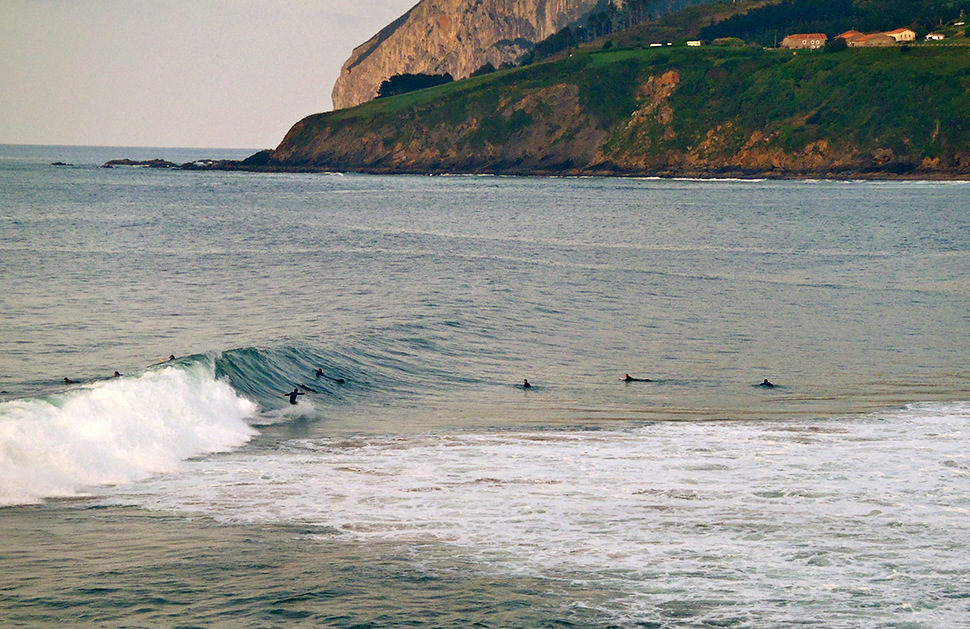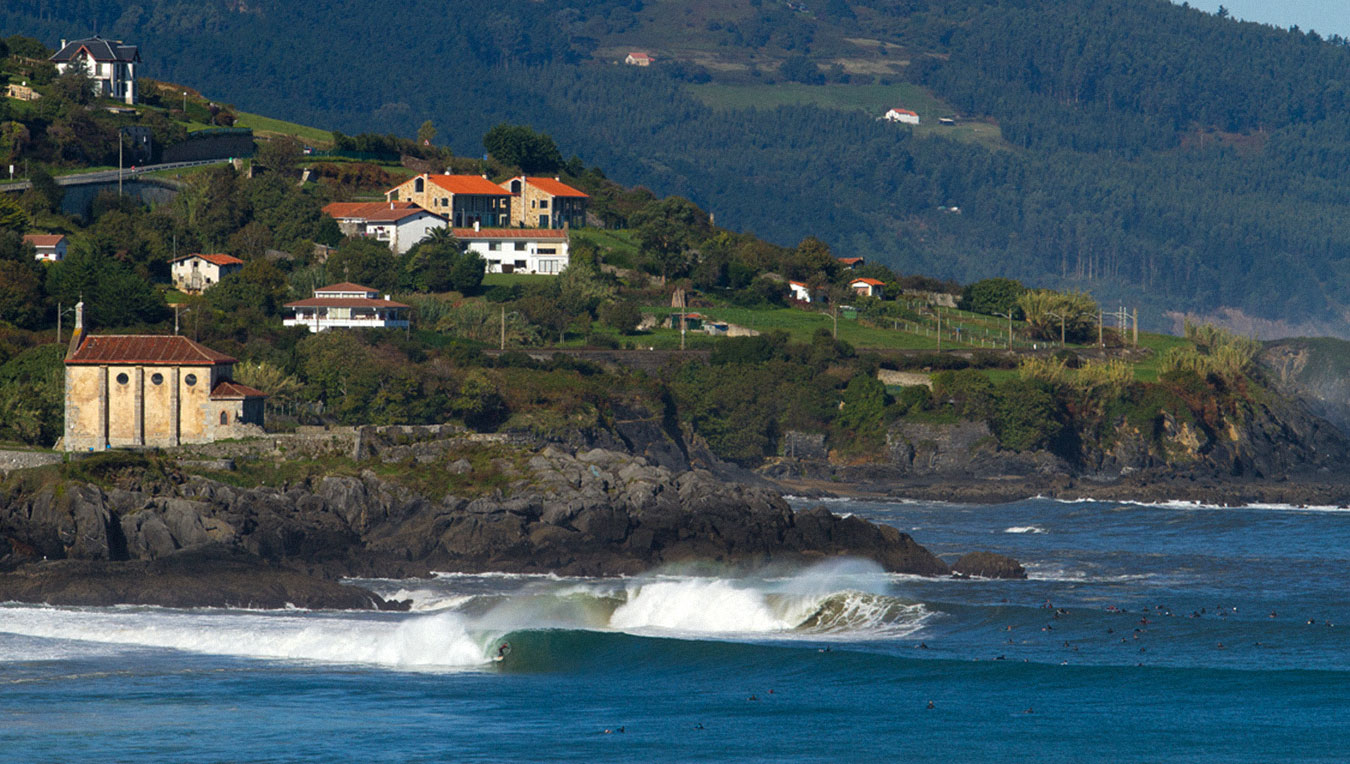Mundaka – Surf,Bodyboard – Northern Spain – Basque Country

 Surfergalaxy
Surfergalaxy 
| Wave | Long left hand witth Barrel sections |
| Ola | Brazo de izquierdas con secciones Tubulares |
| Wind | S - SW - W - NW |
| Tide | Low Tide |
| Marea | Marea Baja |
| Swell | NW |
| Bottom | Sand |
| Fondo | Arena |
| Time of year | Autum - Winter |
| Época del año | Otoño - Invierno |
For Mundaka to be its classic self it needs strong NW swells of 6 to 8 feet, low tide and S – SW wind. If that happens the best surfers go, including some from Las Landas in France where the wave is very similar. This left starts working from 4 feet and sometimes a short and intensive right which is popular with bodyboarders also leaves the peak. It’s worth considering that the choppy conditions that are so common with the autumn and winter storms can be good due to the quality of the seabed and the protection of the inlet.
The best time is from the end of September until December when the calmness, the quality of the bottom, and the first autumn swells are often the best. From then on you can surf frequently thanks to the continuous input of one swell after another. Sometimes the core winter months lead to spectacular swells exclusively for experienced surfers. Keep in mind that the conditions aren’t long lasting and so you need to be very aware of the state of the tide and also the currents that are close to the harbour and the take off zone in mid to low tide. It’s normally very busy at this spot but it’s worth a shot if you stay aware of your own limits and leave the locals to set the pace. Although the last sections aren’t always good, they’re a good option and there are usually less people there.
Mundaka para estar clásica necesita mares fuertes del NW de 6, 8 pies, marea baja y viento S-SW, si eso ocurre los mejores surfers vienen incluso desde Las Landas en Francia, donde la ola es muy apreciada. Esta izquierda empieza a funcionar desde los 4 pies, a veces en el pico sale una corta e intensa derecha frecuentada por algunos boogies y es bueno considerar que las condiciones choppy que son tan habituales con las borrascas de otoño e invierno pueden ser buenas debido a la calidad del fondo y la protección de la ría.
La mejor temporada es desde finales de septiembre hasta diciembre, la templanza, la calidad de los fondos y los primeros golpes de mar del otoño suelen ser los mejores. A partir de ahí los baños son frecuentes gracias a la entrada continua de swell uno detrás de otro, también en ocasiones los meses centrales del invierno dan lugar a espectaculares maretones exclusivos para tamañeros. Tened en cuenta que las condiciones no son duraderas, hay que estar muy pendiente del estado de la marea porque la ola cambia radicalmente de forma y dinámica, hay que conocer también las corrientes cerca del puerto y la zona de take off en marea media – baja. Es un spot que normalmente está muy masificado pero merece la pena intentarlo siempre conociendo los límites que cada uno tiene y dejando que sean los locales quienes marcan los tiempos. Las últimas secciones aunque no son tan buenas siempre son buena opción y hay menos gente.

The famous Mundaka left, known as one of the ten best lefts in the world, is in Bizkaia in the Basque Country, northern Spain. This small old fishing village has evolved on the west side of the river mouth since the year 900, around what was a natural harbour protected from the ferocity of the Cantabrian Sea. Surfers go in the water in front of the harbour and the main pier searching for the sandbar from where Mundaka originates. Mundaka can reach 400 metres and at low tide it sometimes converts into a deep barrel that can reach 100 metres. Big Basque surfers like Eneko Acero or Aritz Aramburu are regulars at the sandbar and can vouch that Mundaka has nothing to envy about any other barrel in the world and despite the fact that you can get hurt by it, the sandy bottom allows you to take your surfing to unthinkable limits over a coral reef.
To get to Mundaka, you can take the BI-635 from Gernika in the direction of Bermeo, or the BI-631 from Bilbao which takes 45 minutes. Be warned that if you go in the summer it’ll be very busy. Next to the harbour you’ll find Atalaya Park, the nucleus of the town, and from there you can see the whole of the Mundaka line up and Ízaro island, where there is quiet right-hander which you can only get to by boat, in the background.
Since the seventies Mundaka, along with Hossegor in France, has been a benchmark for European surfing and for this reason it has a long history with an endless list of surfers; Garaizabal, Susaeta, Morenés, Escauriaza, the Gandarias, the Lekumberris, the Natxo brothers, Jaime, Txema Fernandez, Jupa Soler, Jorge Imbert, Gorka Yarritu, Asis Fernandez, Josu Bearan, David Bustamante, all legendary like Bruce Smith who discovered Mundaka at the beginning of the eighties and got so trapped by the place and its culture that he opened his workshop Odyssey Surfboards there. It was a similar situation for the Australians Craig Sage and Nick Lavery, or more recently, Mike Dobos.
Mundaka Surfing
It’s of high importance worldwide and was in fact with the Billabong Pro Mundaka, one of the most compelling tests of the WCT, for a long time. However, a slump in the conditions in recent years led to the parties involved suspending this stop of the tour as it’s difficult to get the correct tide and swell factors coinciding. This was a very sad decision but nothing compared to the sadness caused by a catastrophe in 2003 when sand dredging at the river mouth wiped out the wave. This news spread globally and caused an empty feeling for three long years until the first autumn swells of 2005 when it seemed like something was changing and on the 18th February 2006, some, such as Txema Fernandez, Iker Acero, Josu Bearan and Mike Dobos entered the water with a big swell that brought sets of three, hollow four metre waves which they couldn’t cope with. It was a session that they hadn’t seen for years and it confirmed that Mundaka had returned as quickly as it had left, hence the slogan that symbolised the Billabong Pro Mundaka in October 2006, ‘She’s back and she’s angry’.
La famosa Izquierda de Mundaka es conocida como una de las diez mejores izquierdas del mundo, se encuentra en la provincia de Bizkaia (País Vasco, al Norte de España. En el lado Oeste de la desembocadura de la ría se ubica, desde su fundación en el año 900, ésta antigua villa de pescadores. Una pequeña población que ha crecido en torno a lo que fue un puerto natural que protegía de la bravura del Mar Cantábrico. Actualmente, este bonito puerto está protegido por un muelle que es usado también por los surfers para echarse al agua. El banco de arena que origina la barra de Mundaka puede llegar a los 400 metros, si hay buenas condiciones, en marea baja el tubo puede alcanzar los 100 metros. Grandes surfistas vascos como Eneko Acero o Aritz Aramburu son asiduos a la barra, nadie mejor que ellos para afirmar que Mundaka no tiene nada que envidiar a ningún tubo del mundo y en el que, a pesar de que puedes hacerte daño, gracias al fondo de arena podrás llevar tu surfing a unos límites impensables en un arrecife de coral.
Para llegar a Mundaka puedes tomar la carretera BI-635 desde Gernika en dirección a Bermeo, o la BI-631 desde Bilbao a 45 minutos. Atento si vas en época de verano cuando la ocupación es muy alta. Al lado del puerto se encuentra el parque de la Atalaya, centro neurálgico del pueblo y desde el que se observa todo el line-up de Mundaka con la isla de Ízaro al fondo, donde rompe una derecha poco frecuentada ya que solo se puede llegar allí en barco.
Mundaka es desde los años 70 junto con Hossegor, en Francia, el punto de referencia del surfing europeo, es por ello que posee una dilatada historia con una lista inacabable de surfers, Garaizabal, Susaeta, Morenés, Escauriaza, Los Gandarias, Los Lekumberris, los hermanos Natxo, Jaime, Txema Fernandez, Jupa Soler, Jorge Imbert, Gorka Yarritu, Asis Fernandez, Josu Bearan, David Bustamante ‘Zumo’, míticos todos, al igual que Bruce Smith, quien descubrió Mundaka a principios de los ochenta y quedó atrapado por el lugar y su cultura, abriendo el taller Odyssey Surfboards. Situación muy similar a la que vivieron los australianos Craig Sage o Nick Lavery o más recientemente Mike Dobos. A nivel mundial tiene una importancia máxima y de hecho durante mucho tiempo fue sede del ‘Billabong Pro Mundaka’ una de las pruebas más atractivas del WCT, sin embargo, una mala racha de condiciones los últimos años llevó a las partes implicadas a su suspensión dentro del ‘Tour’ por la dificultad de que coincidieran todos los factores de swell y marea.
Mundaka Surfing
Esta decisión fue muy triste, pero sin embargo, nada comparado con la tristeza que ocasionó la catástrofe de 2003 cuando un dragado de arena en la boca de la ría hizo desaparecer la ola. Este hecho difundido a nivel mundial causo una sensación de vacío enorme durante tres largos años hasta que con las primeras marejadas del otoño 2005 algo parecía que estaba cambiando, y el 18 de febrero de 2006 algunos como Txema Fernandez, Iker Acero, Josu Bearan, Mike Dobos entraron al agua con una gran marejada que traía series de tres, cuatro metros huecos y olas a las que no se podían enfrentar. Fue una sesión como no se veía en años que confirmaba que Mundaka al igual que un día de pronto se fue, ese día había vuelto. De ahí el lema que simbolizo el ‘Billabong Pro Mundaka’ de Octubre de 2006, «She’s back and she’s angry»
Mundaka forms part of the Urdaibai Biosphere Reserve which is an area of high environmental value as declared by UNESCO. There are valuable wetlands linked to the inlet, a huge variety of bird species, native forests, and the special geological formation of its coast. The small fishing harbour is lovely and there are some exceptional eateries where you can enjoy the typical tapas while you wait for the swell. There are two excellent viewing points at the top of Portuondo and from the village watchtower. Mundaka is the starting point for the trekking route that follows the river to Guernica town and others that go through Urdaibai. It’s possible to do other things like windsurfing at Laida beach, mountain biking, sailing, canoeing, running etc.
Mundaka forma parte de la Reserva de la Biosfera de Urdaibai, zona de alto valor ambiental declarada así por la UNESCO. Aquí son muy valiosas sus zonas húmedas ligadas a la ría, la enorme variedad de especies de aves, los bosques autóctonos, y la especial formación geológica de su costa. El pequeño puerto de pescadores es encantador y cuenta con excepcionales tascas donde disfrutar de los típicos pintxos mientras esperas la marea, tienes dos excepcionales miradores en el alto de Portuondo y en la atalaya del pueblo. Mundaka es punto de partida del sendero que remonta la ría hasta la localidad de Guernica y también de otros que recorren todo el Urdaibai. Es posible practicar otras opciones como windsurf en la playa de Laida, mountain bike, vela, piragüismo, footing…